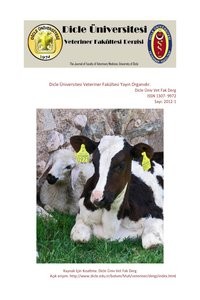Abstract
Although the chemical and molecular structure of DNA understood, thanks to the findings of the last ten years, is known that
everything is not over the DNA. To sustain of the life are requires of the appropriate response to environmental stimuli. Embryo to
until the end of life, changes in gene expression observed. Genes in the genome is expressed at certain times and in certain cells.
This new grip is called that "epigenetic". All of the mechanisms of epigenetic regulation is called that "epigenome". Epigenetic
alterations cause of the gene silencing or activation, such as a genetic mutation or deletion mechanism. However, epigenetic
alterations are emerging without change of the base sequence, and occurring often recyclable. Arrangement of the gene regulation is
vital importance to understanding of the cells how they differentiated and they can be carcinogenic. In this study the information is
compiled about that epigenetic, which is important at least as genetic.
References
- 1- Meaney, M. J., and Szyf, M. (2005). Maternal care as a model for experience-dependent chromatin plasticity? Trends in Neuroscience, 28(9), 456-463.
- 2- Karaçay B., Yaşamın sırrı DNA. Tubitak yayınları (2010).
- 3- Cooper MG, Hausman ER. The cell a molecular approach.3rded. USA, 150- 4. (2004).
- 4- Strahl DB, Allis D. The language of covalent histone modifications. Nature 403:41-5 ( 2000).
- 5- Grant AP. A tale of histone modifications. Genome Biol2:1- 6(2001).
- 6- Peterson LC, Laniel M. Histones and histone modifications.Curr Biol 14:546-51 (2004).
- 7- Egger G, Liang G, Aparicio A, Jones AP. Epigenetics in human disease and prospects for epigenetic therapy. Nature. 429:457-63 (2004).
- 8- Robertson DK. DNA methylation and human disease. Nature Rev Genet 6:597-610 (2005).
- 9- Miyamoto K, Ushijima T. Diagnostic and therapeutic applications of epigenetics. Jpn J Clin Oncol 35:293- 301 ( 2005).
- 10- İzmirli M., Epigenetik Mekanizmalar ve Kanser Tedavisinde Epigenetik Yaklaşımlar. Van Tıp Dergisi, Cilt:20, Sayı:1 (2013).
- 11- Bora G. Yurter H.E.; Epigenetik hastalıklar ve tedavi yaklaşımları. Hacettepe Tıp Dergisi, 38.48-54 (2007).
- 12- Manikkam M., Tracey R., GuerreroBosagna C., Skinner MK. Dioxin(TCDD) Induces Epigenetic transgenerational ,inheritance of adult onset disease and sperm epimutations. Plosone 7(9):e46249 (2012).
Abstract
Her ne kadar DNA‟nın kimyasal ve moleküler yapısı anlaşılmış olsa da, son on yıldır elde edilen bulgular sayesinde artık her şeyin
DNA‟da bitmediği bilinmektedir. Yaşamı sürdürebilmek için çevresel uyaranlara uygun tepki göstermeyi gerektirir. Embriyodan
yaşamın sonuna kadar geçen süreçte, gen ifadelerinde değişiklikler gözlemlenir. Genomda bulunan genler, belirli hücrelerde ve
belirli zamanlarda ifade edilir. Bu yeni kavrama “genler üstü genetik” anlamına gelen “epigenetik” denilmektedir. Epigenetik
düzenlemelerde ve mekanizmalarda yer alan tüm oluşumlara ise “epigenom”denir. Epigenetik değişikler bir genin aktivasyonuna ya
da sessizleşmesine neden olurlar, bu ise bir geni aktive edici, mutasyon ya da delesyon gibi genetik bir mekanizmaya benzerdir.
Fakat, epigenetik değişiklikler baz dizisinde bir değişime neden olmadan ortaya çıkarlar ve çoğu kez geriye dönüşümlüdür. Gen
regülasyonunun düzenlenmesi, hücrelerin nasıl differansiye olduklarının belirlenmesinde ve nasıl kansorejen hale geldiklerinin
anlaşılmasında hayati önem taşımaktadır. Bu çalışmada en az genetik kadar önemli ve çok yeni olan epigenetik hakkında, bilgiler
derlenmiştir.
References
- 1- Meaney, M. J., and Szyf, M. (2005). Maternal care as a model for experience-dependent chromatin plasticity? Trends in Neuroscience, 28(9), 456-463.
- 2- Karaçay B., Yaşamın sırrı DNA. Tubitak yayınları (2010).
- 3- Cooper MG, Hausman ER. The cell a molecular approach.3rded. USA, 150- 4. (2004).
- 4- Strahl DB, Allis D. The language of covalent histone modifications. Nature 403:41-5 ( 2000).
- 5- Grant AP. A tale of histone modifications. Genome Biol2:1- 6(2001).
- 6- Peterson LC, Laniel M. Histones and histone modifications.Curr Biol 14:546-51 (2004).
- 7- Egger G, Liang G, Aparicio A, Jones AP. Epigenetics in human disease and prospects for epigenetic therapy. Nature. 429:457-63 (2004).
- 8- Robertson DK. DNA methylation and human disease. Nature Rev Genet 6:597-610 (2005).
- 9- Miyamoto K, Ushijima T. Diagnostic and therapeutic applications of epigenetics. Jpn J Clin Oncol 35:293- 301 ( 2005).
- 10- İzmirli M., Epigenetik Mekanizmalar ve Kanser Tedavisinde Epigenetik Yaklaşımlar. Van Tıp Dergisi, Cilt:20, Sayı:1 (2013).
- 11- Bora G. Yurter H.E.; Epigenetik hastalıklar ve tedavi yaklaşımları. Hacettepe Tıp Dergisi, 38.48-54 (2007).
- 12- Manikkam M., Tracey R., GuerreroBosagna C., Skinner MK. Dioxin(TCDD) Induces Epigenetic transgenerational ,inheritance of adult onset disease and sperm epimutations. Plosone 7(9):e46249 (2012).
Details
| Subjects | Veterinary Surgery |
|---|---|
| Journal Section | Review |
| Authors | |
| Publication Date | January 1, 2013 |
| Published in Issue | Year 2013 Issue: 1 |


